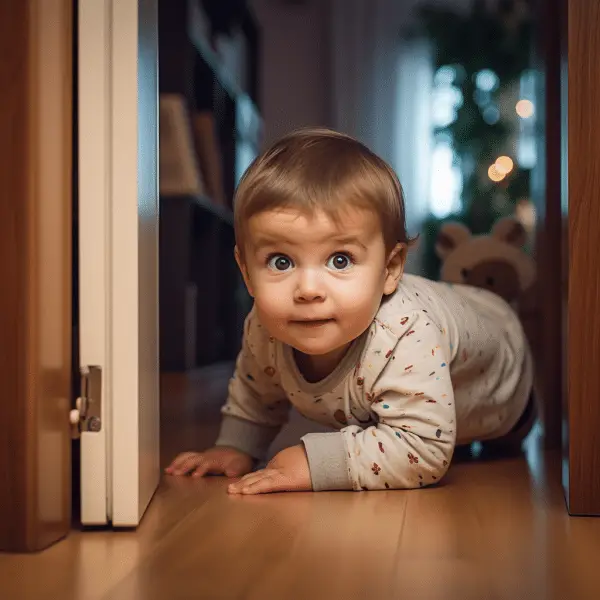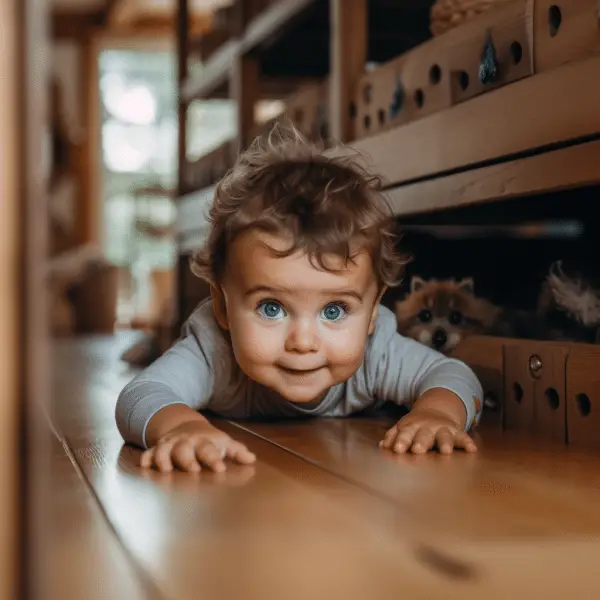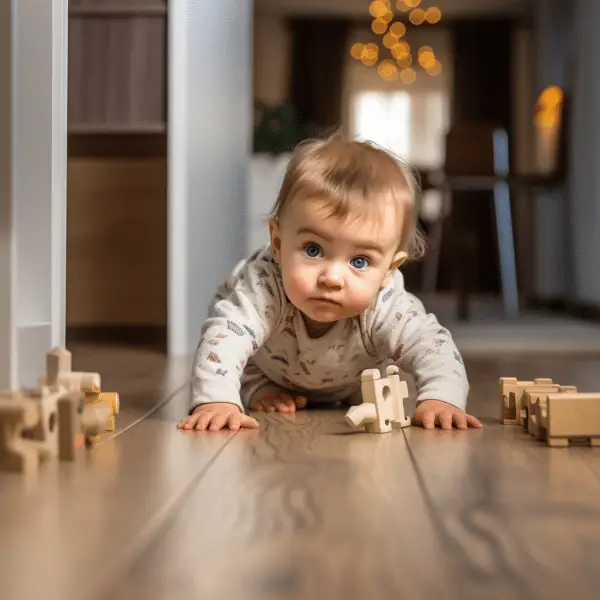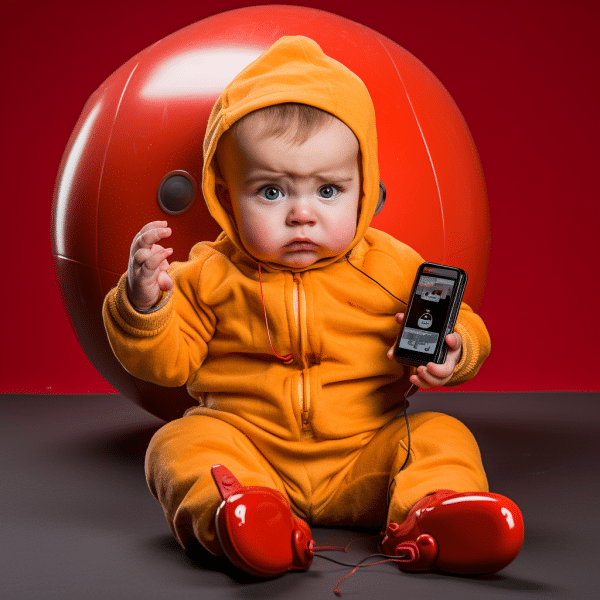Essential Babyproofing Guide for a Safe Home
Babyproofing your home is a crucial step in ensuring the safety of your little one. By creating a secure environment, you can allow your baby to explore and develop while minimizing potential risks. In this article, I will guide you through the process of baby-proofing your home, providing tips and solutions for each room.
Key Takeaways:
- Baby-proofing your home is essential for infant safety and home safety.
- Creating a safe environment promotes brain development, physical skills, independence, and problem-solving abilities.
- Assess each room in your home for potential hazards and implement appropriate safety measures.
- As your baby grows, be aware of the specific risks associated with crawling, walking, and exploration.
- Follow babyproofing do’s and don’ts to ensure you are taking the right steps to protect your baby.

Why Allow Babies to Roam?
The exploration and roaming of babies play a crucial role in their overall development. It is through this process that they learn about the world around them, develop essential skills, and foster their independence and problem-solving abilities. Allowing babies to roam freely in a safe environment can have numerous benefits for their cognitive, physical, and emotional growth.
Baby development is highly influenced by their sensory experiences. When babies are given the freedom to explore, they engage their senses and learn about different textures, shapes, sounds, and smells. This sensory input contributes to the development of their brain connections and helps them make sense of the world.
Furthermore, allowing babies to roam promotes their physical development. It encourages them to crawl, walk, and eventually explore their surroundings independently. These physical activities enhance their motor skills, coordination, and muscle strength. It also gives them the opportunity to understand spatial relationships and develop a sense of balance and coordination.
“The importance of allowing babies to explore and roam cannot be overstated. It is through this hands-on exploration that they learn about cause and effect, problem-solving, and develop their own unique understanding of the world.”
Moreover, roaming and exploration foster independence and problem-solving abilities in babies. When they are given the freedom to explore, babies encounter various challenges and obstacles. It is through these experiences that they learn to overcome difficulties, problem-solve, and become more self-reliant. Allowing babies to explore their surroundings also encourages their curiosity and promotes their sense of adventure.
Why Allow Babies to Roam?
| Benefits | Explanation |
|---|---|
| Cognitive Development | Allows babies to engage their senses, develop brain connections, and make sense of the world. |
| Physical Development | Promotes motor skills, coordination, muscle strength, and spatial understanding. |
| Independence and Problem-Solving | Encourages self-reliance, problem-solving abilities, and fosters curiosity and a sense of adventure. |
Babyproofing: Assessing the Rooms
Before you begin the process of babyproofing your home, it’s crucial to assess each room for potential hazards. By identifying the risks in various areas of the house, you can take proactive measures to create a safe and secure environment for your little one. Here’s a detailed guide on how to babyproof different rooms, ensuring your baby’s safety every step of the way.
Bedroom Safety
In the bedroom, pay attention to potential hazards such as loose crib sheets or bedding, small toys, unstable furniture, blinds or curtain cords, outlets, and sharp edges on furniture. Ensure that the crib meets safety standards and that the mattress fits snugly. Consider using furniture anchors to secure dressers and bookshelves to prevent tipping accidents.
Living Room Safety
The living room is a space where families spend a significant amount of time, so it’s essential to make it safe for your baby. Focus on securing electrical outlets with outlet covers and using cord shorteners to prevent tripping hazards. Remove or secure loose cords and ensure that coffee tables have rounded corners. Keep small objects out of reach and consider anchoring furniture to the wall to prevent tipping.
Kitchen Safety
The kitchen can be filled with potential hazards for a curious little one. Take measures to keep sharp objects, chemicals, and hot surfaces out of reach. Store cleaning supplies in locked cabinets or high shelves. Consider installing cabinet locks to keep your baby away from accessible trash bins and ensure heavy pots and pans are securely stored. It’s also essential to use stove knob covers to prevent accidental ignition.
| Room | Common Hazards | Safety Solutions |
|---|---|---|
| Bedroom | Loose crib sheets or bedding, small toys, unstable furniture, blinds or curtain cords, outlets, sharp edges on furniture | Secure crib properly, remove small toys, anchor furniture, use cordless blinds, cover outlets, and use corner guards |
| Living Room | Electrical outlets, loose cords, coffee tables with sharp corners, small objects, fireplace tools, loose rugs or carpets | Install outlet covers, secure cords, use corner guards on tables, remove small objects, keep fireplace tools out of reach, secure rugs or carpets |
| Kitchen | Sharp objects, chemicals, hot surfaces, small objects, accessible trash bins, heavy pots or pans | Store sharp objects and chemicals out of reach, install stove knob covers, use cabinet locks, secure trash bins, and store heavy items safely |
Risks in Baby’s Growth Stages
As babies grow and reach different developmental stages, their exploration and mobility increase, along with potential hazards. It is important for parents to be aware of these risks to ensure their baby’s safety. Let’s take a closer look at the crawling, walking, and exploration stages and the associated hazards to watch out for.
Risks During Crawling
During the crawling stage, babies are prone to accidents and injuries as they explore their surroundings. Some common crawling hazards include:
- Electrical cords or outlets, which pose a risk of electrical shock if pulled or chewed.
- Small objects that can be choking hazards if accidentally swallowed.
- Unsecured furniture or appliances that can tip over if climbed upon.
- Exposed sharp edges or corners on furniture, which can cause injuries.
Parents should take proactive measures to address these hazards, such as using outlet covers, removing small objects from reach, securing furniture to the wall, and using corner guards on furniture edges.
Risks During Walking
As babies start to walk, they become more independent and curious, which introduces new risks. Some hazards to be aware of during the walking stage include:
- Unstable stairs or uneven surfaces, which can lead to falls.
- Slippery floors or rugs that can cause accidents.
- Unsecured doors or cabinets that may pinch fingers or contain hazardous items.
- Accessible cleaning supplies or toxic substances that pose poisoning risks.
To prevent accidents, parents should install safety gates at the top and bottom of stairs, secure rugs with non-slip pads, use door and cabinet locks, and ensure cleaning supplies are out of reach or stored in locked cabinets.
Risks During Exploration
During the exploration stage, babies become more curious and start to interact with their environment in a variety of ways. Some hazards to consider during this stage include:
- Choking hazards, such as small toys or objects that can be easily swallowed.
- Accessible cords or blinds that can pose strangulation risks.
- Sharp or breakable objects that can cause injuries.
- Unsecured windows or balconies that may lead to falls.
To ensure a safe exploration environment, parents should keep small objects out of reach, install cordless window coverings, remove or secure sharp objects, and use window guards or locks to prevent falls.
| Stage | Hazards | Preventive Measures |
|---|---|---|
| Crawling | Electrical cords, small objects, unsecured furniture, sharp edges | Use outlet covers, remove small objects, secure furniture, use corner guards |
| Walking | Unstable stairs, slippery floors, unsecured doors, accessible cleaning supplies | Install safety gates, use non-slip pads, use door and cabinet locks, store cleaning supplies out of reach |
| Exploration | Choking hazards, accessible cords, sharp objects, unsecured windows | Keep small objects out of reach, install cordless window coverings, remove or secure sharp objects, use window guards or locks |
Babyproofing Tips: Creating a Safe Environment for Your Little One
When it comes to babyproofing your home, there are some important do’s and don’ts to keep in mind. By following these tips, you can create a safe environment for your little one to explore and grow.
Do’s of Babyproofing:
- Secure furniture: Anchor heavy furniture to the wall to prevent tipping.
- Use safety locks: Install safety locks on cabinets and drawers to keep hazardous items out of reach.
- Cover electrical outlets: Use outlet covers or safety plugs to prevent little fingers from getting electrocuted.
- Install gates: Use safety gates to block off stairs and other areas that may pose a risk.
- Use corner guards: Protect your baby from sharp corners on furniture by using corner guards or edge bumpers.
Don’ts of Babyproofing:
- Don’t rely on baby walkers: Baby walkers can be dangerous and increase the risk of falls and accidents.
- Don’t leave small objects within reach: Keep small objects, such as coins and small toys, out of your baby’s reach to prevent choking hazards.
- Don’t forget about window safety: Install window locks or guards to prevent falls from open windows.
- Don’t overlook cords and blinds: Keep cords and blinds out of reach to prevent strangulation.
- Don’t neglect fire safety: Install smoke detectors and fire extinguishers throughout your home to ensure a safe environment.
“Babyproofing requires careful consideration of what to do and what to avoid.”
By following these babyproofing tips and being proactive in creating a safe environment, you can provide your little one with the freedom to explore while minimizing potential hazards. Remember, babyproofing is an ongoing process, so be sure to regularly reevaluate and update your safety measures as your baby grows and develops.
| Item | Do | Don’t |
|---|---|---|
| Secure furniture | Anchor heavy items to prevent tipping | Assume furniture is stable without anchoring |
| Use safety locks | Install locks on cabinets and drawers | Leave hazardous items accessible |
| Cover electrical outlets | Use outlet covers or safety plugs | Leave outlets uncovered or exposed |
| Install gates | Block off stairs and dangerous areas | Assume baby can navigate stairs safely |
| Use corner guards | Protect from sharp furniture corners | Leave sharp corners exposed |
Emergency Preparedness
When it comes to babyproofing, being prepared for emergencies is just as important as preventing accidents in the first place. As a parent, it’s crucial to establish an action plan and have an emergency kit ready for any unforeseen circumstances. Here are some essential steps to take:
- Create an action plan: Sit down with your partner or family members and discuss what to do in different emergency situations. Assign roles and responsibilities so that everyone knows what to do in case of an emergency.
- Prepare an emergency kit: Stock up on essential items that you may need during emergencies. This includes first aid supplies, extra diapers, non-perishable food, bottled water, and a flashlight with extra batteries. Keep the kit in a designated area that is easily accessible.
- Learn CPR and basic first aid: Taking a CPR and first aid course can give you the knowledge and skills necessary to provide immediate care in case of an emergency. It’s a valuable skill that can potentially save your baby’s life.
Remember, emergencies can happen at any time, so it’s important to stay vigilant and be prepared. By having an action plan and an emergency kit, you’ll be ready to handle any situation that may arise.
Table: Essential Items for an Emergency Kit
| Item | Quantity |
|---|---|
| First Aid Supplies | 1 kit |
| Extra Diapers | 5-7 |
| Non-perishable Food | 3-day supply |
| Bottled Water | 1 gallon per person per day |
| Flashlight | 1 |
| Extra Batteries | 4 |
Having an emergency kit stocked with these essential items will ensure that you’re prepared for any emergency that may come your way. Remember to periodically check and update your kit to ensure that everything is in good working order and not expired.
Should You Call an Expert?
While many aspects of babyproofing can be handled by parents, there are situations where calling in an expert can provide additional peace of mind. Professional babyproofing services offer specialized knowledge and experience in assessing potential hazards and implementing effective solutions. Here are a few scenarios where consulting an expert may be beneficial:
- If you have a particularly complex or large home: A professional babyproofing expert can assess the entire property, including rooms, outdoor spaces, and any unique features, to ensure comprehensive safety measures are in place.
- If you lack the time or expertise: Babyproofing can be a time-consuming task, especially for busy parents. Hiring a professional allows you to focus on other priorities while trusting that the job will be done thoroughly and efficiently.
- If you’re unsure of the latest safety standards: Safety guidelines and regulations change over time. An expert can provide up-to-date knowledge on the best practices for babyproofing, ensuring your home meets the current safety standards.
- If you need customized solutions: Every home is different, and what works for one may not work for another. A babyproofing expert can tailor the solutions to your specific needs and address any unique challenges you may have.
When selecting a professional babyproofing service, it’s important to do thorough research and choose a reputable provider. Look for companies with positive reviews, certifications, and a track record of successful projects. Additionally, consider requesting a consultation or quote to discuss your specific needs before committing to their services.
Remember, the safety of your baby is worth investing in. Calling an expert can give you peace of mind, knowing that your home is properly babyproofed and that potential risks have been minimized.
Expert Tip:
Even if you decide to hire a professional babyproofing service, it’s still essential to stay involved in the process. Communicate openly with the expert, sharing any concerns or specific requirements you may have. Be present during the assessment and installation stages to ensure the solutions align with your expectations and meet your safety goals.
| Benefits of Professional Babyproofing Services | Considerations When Hiring an Expert |
|---|---|
| 1. Expert knowledge and experience | 1. Reputation and reviews |
| 2. Comprehensive assessment of your home | 2. Certifications and qualifications |
| 3. Up-to-date knowledge of safety standards | 3. Customization options |
| 4. Time-saving for busy parents | 4. Transparent pricing and quotes |
Bedroom Safety Solutions
When it comes to babyproofing your home, the bedroom is a crucial space to consider. To create a safe sleeping environment for your baby, there are several key safety solutions to implement. Firstly, ensure that your crib meets current safety standards and is free from any loose bedding, pillows, or stuffed animals that could pose a suffocation risk. Secondly, secure any furniture, such as dressers or bookshelves, to the wall using furniture anchors to prevent tipping accidents. This is especially important once your baby starts pulling themselves up and potentially using the furniture for support.
If you have blinds or curtains in the bedroom, be mindful of cords that could become a strangulation hazard. Use cord shorteners or cordless window coverings to eliminate this risk. Additionally, make sure all electrical outlets in the room are covered with outlet covers to prevent your little one from inserting objects into them. Finally, inspect the room for any sharp edges or corners on furniture that could pose injury risks. Consider using corner guards or padding to protect your baby from accidental bumps and bruises.
By implementing these bedroom safety solutions, you can create a secure and peaceful sleeping environment for your baby.
| Safety Solutions | Description |
|---|---|
| Crib Safety | Ensure the crib meets safety standards and is free from loose bedding or stuffed animals. |
| Furniture Anchors | Secure dressers and bookshelves to the wall to prevent tipping accidents. |
| Blinds or Curtain Cords | Use cord shorteners or cordless window coverings to eliminate the risk of strangulation. |
| Electrical Outlets | Cover all outlets with outlet covers to prevent object insertion. |
| Sharp Edges | Protect your baby from accidental bumps and bruises by using corner guards or padding on furniture. |
Living Room Safety Solutions
When babyproofing your home, it’s crucial to pay special attention to the living room, as it is a common area where your little one spends a lot of time. By addressing potential hazards in this room, you can create a safe environment for your baby to explore and play. Here are some key safety solutions to consider:
- Electrical Outlets: Covering electrical outlets is essential to prevent your baby from inserting objects into them. Use outlet covers or safety plugs to ensure that all outlets are securely covered. Additionally, consider rearranging furniture to block access to outlets.
- Sharp Corners: Coffee tables and other furniture with sharp corners can pose a risk to your baby. Use corner guards or edge bumpers to cushion sharp edges and minimize the risk of injury.
- Loose Cords: Cords from window blinds or electrical devices should be secured and kept out of reach. Use cord shorteners or wrap cords around cord winders to prevent entanglement.
By implementing these safety solutions, you can significantly reduce the risk of accidents and create a safe living room environment for your baby. Remember to reassess the room periodically as your baby grows and becomes more mobile to ensure ongoing safety.
Kitchen Safety Solutions
When it comes to babyproofing your home, the kitchen is one area that requires extra attention. With its sharp objects, chemicals, hot surfaces, and accessible trash bins, the kitchen can pose numerous risks to your little one’s safety. By implementing the right safety solutions, you can create a secure environment for your baby to explore and grow.
Sharp Objects
The kitchen is filled with sharp objects like knives, scissors, and graters that can cause serious injuries to a curious baby. It’s important to keep these items out of reach by storing them in locked drawers or high cabinets. Additionally, consider using knife blocks or magnetic strips to secure sharp utensils and ensure they are not within your baby’s reach.
Chemicals
Household cleaning products and chemicals should be stored securely in locked cabinets or placed out of reach in high storage areas. This will prevent your baby from accidentally ingesting or coming into contact with harmful substances. Be sure to use child-resistant locks on cabinets containing cleaning supplies to provide an extra layer of protection.
Hot Surfaces
To prevent burns or scalds, make sure to install stove knob covers to prevent your baby from accidentally turning on the burners. Use back burners whenever possible and turn pot handles towards the back of the stove to keep them out of your baby’s reach. It’s also a good idea to use oven door locks to prevent your baby from opening a hot oven.
Accessible Trash Bins
Trash bins in the kitchen can contain choking hazards, sharp objects, or toxic substances. Consider using trash bins with secure lids or choose ones with babyproof locks. If your trash bin is not babyproof, make sure it is stored in a locked cabinet or in an area that is inaccessible to your baby.
| Kitchen Safety Solutions | Implementations |
|---|---|
| Sharp Objects | Store knives and sharp utensils in locked drawers or high cabinets |
| Chemicals | Store household cleaning products in locked cabinets or high storage areas |
| Hot Surfaces | Install stove knob covers, use back burners, and use oven door locks |
| Accessible Trash Bins | Use trash bins with secure lids or babyproof locks |
Nursery Safety Solutions
When it comes to babyproofing your nursery, it’s important to pay attention to potential hazards that could pose a risk to your little one. By taking proactive measures, you can create a safe and secure environment for your baby to grow and explore. Here are some nursery safety solutions to consider:
Small Parts
Babies have a natural curiosity and tend to put everything in their mouths. To prevent choking hazards, ensure that all toys in the nursery are age-appropriate and do not have small parts that can be easily swallowed. Regularly inspect toys and remove any broken or loose pieces.
Cords
Cords from window blinds, curtains, or baby monitors can pose strangulation risks. Use cord shorteners or tie cords up high and out of reach. You can also opt for cordless window coverings to eliminate this hazard completely.
Lightweight Objects
Babies start exploring their surroundings and grabbing objects as they grow. Ensure that lightweight items such as decorations or mobiles are securely fastened and out of reach. Keep shelves and dressers properly anchored to prevent tipping over.
By implementing these nursery safety solutions, you can create a secure environment for your baby’s growth and development. Remember to regularly reassess and update your babyproofing measures as your little one reaches new milestones.
| Common Nursery Hazards | Safety Solutions |
|---|---|
| Small parts on toys | Choose age-appropriate toys without small parts; regularly inspect toys for loose or broken pieces. |
| Cords from blinds or curtains | Use cord shorteners or tie cords up high and out of reach; consider cordless window coverings. |
| Lightweight objects on shelves | Securely fasten decorations or mobiles; keep shelves and dressers properly anchored. |
Conclusion
Creating a safe and secure home for your little one is of utmost importance. Babyproofing is the key to ensuring their safety as they explore and grow. By following the guidelines outlined in this article, you can create a safe environment for your baby to roam freely and develop their skills.
Throughout the rooms in your home, it is crucial to assess and address potential hazards. From the bedroom to the living room, kitchen, and nursery, each space requires specific safety solutions. Securing furniture, covering electrical outlets, and using safety locks are just a few of the steps you can take to make your home babyproof.
Emergency preparedness is another crucial aspect of babyproofing. Having an action plan in place and an emergency kit ready can help you handle unforeseen circumstances effectively. By being prepared, you can act swiftly and protect your baby in times of need.
In some cases, calling an expert may be necessary. Professional babyproofing services can provide valuable expertise and ensure that no detail is overlooked. When considering professional assistance, be sure to research reputable experts in your area.
In conclusion, babyproofing your home is a vital step towards creating a safe haven for your baby. With careful assessment, proper safety solutions, and emergency preparedness, you can provide a secure environment that promotes your baby’s growth and development. By taking these measures, you can have peace of mind knowing that your little one is protected every step of the way.
FAQ
Why is babyproofing important?
Babyproofing is essential to create a safe environment for your curious little one. It promotes brain development, physical skills, independence, and problem-solving abilities.
What does babyproofing involve?
Babyproofing involves assessing the rooms in your home and identifying potential hazards. It requires securing furniture, covering electrical outlets, using safety locks, and more.
How do I assess each room for potential hazards?
Before starting the babyproofing process, carefully examine each room for risks such as sharp edges, loose cords, small objects, hot surfaces, and accessible hazards.
What should I consider during baby’s growth stages?
As your baby crawls, walks, and explores, new hazards may arise. It’s important to adapt your babyproofing measures accordingly and provide appropriate supervision.
What are some important babyproofing do’s and don’ts?
Do secure furniture, use outlet covers, and cover sharp edges. Don’t rely solely on baby monitors, leave small objects within reach, or neglect to childproof cabinets and drawers.
How can I prepare for emergencies?
Establish an action plan and create an emergency kit with essentials such as first aid supplies, emergency contact information, and necessary medications.
When should I call a professional babyproofing service?
If you feel overwhelmed or unsure about certain babyproofing tasks, it may be beneficial to seek the help of a professional who specializes in child safety.
What are some bedroom safety solutions?
Use furniture anchors to secure dressers and bookshelves, eliminate loose crib sheets or bedding, and ensure blinds or curtain cords are out of reach.
How can I ensure living room safety?
Install outlet covers, choose furniture with rounded corners, secure loose cords and rugs, and keep small objects, fireplace tools, and sharp-edged coffee tables out of reach.
How do I babyproof the kitchen?
Store sharp objects and chemicals out of reach, use high-quality cabinet locks, supervise around hot surfaces, and keep trash bins and heavy pots or pans inaccessible.
What safety solutions should I implement in the nursery?
Remove toys with small parts, use cord shorteners for blinds and mobiles, keep diapering products out of reach, and secure lightweight objects on shelves.







